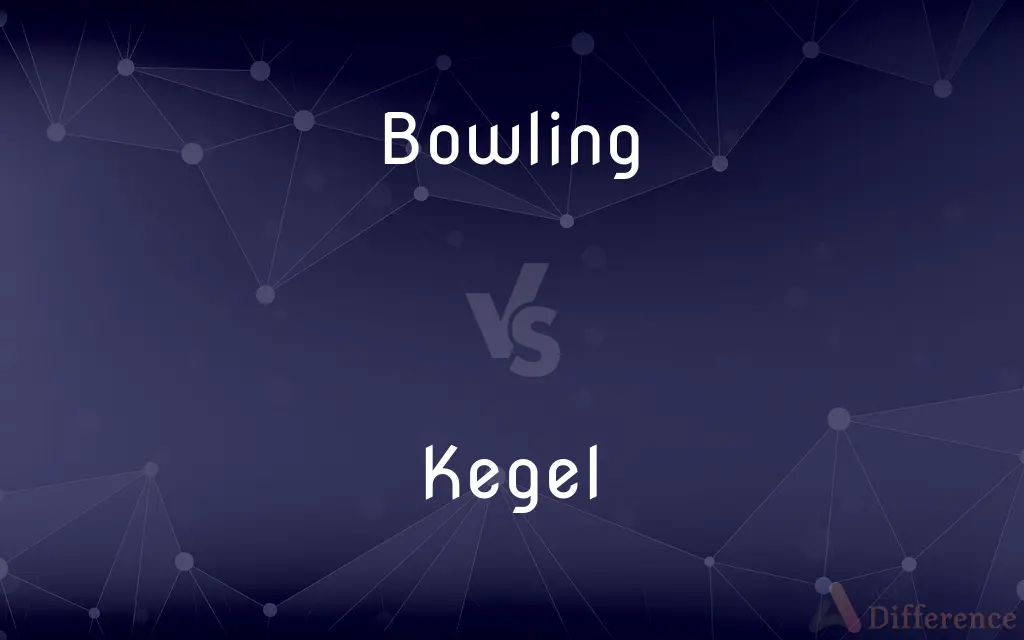Bowling vs. Kegel — What's the Difference?
By Urooj Arif & Fiza Rafique — Updated on April 5, 2024
Bowling is a popular recreational and competitive sport involving rolling a ball to knock down pins, while Kegel, though similar, traditionally involves smaller balls and pins, often without holes in the balls.

Difference Between Bowling and Kegel
Table of Contents
ADVERTISEMENT
Key Differences
Bowling is widely recognized for its standardized gameplay, typically featuring ten pins arranged in a triangle and a heavy ball with finger holes. This sport is played in alleys equipped with lanes that guide the ball towards the pins. The objective is to knock down as many pins as possible, and the game is usually divided into frames, allowing players multiple attempts per game. Kegel, on the other hand, has European origins and predates modern bowling. It can involve various forms but traditionally uses nine pins and a smaller ball without finger holes. The game's settings and rules can vary, reflecting its diverse historical background and regional variations.
In terms of equipment, bowling balls are larger, heavier, and equipped with holes for the thumb, middle, and ring fingers, facilitating a grip that aids in controlling the roll and spin of the ball. Kegel balls are typically smaller, lighter, and lack finger holes, requiring a different technique focused more on precision than power. The size and weight of the pins also differ, with bowling pins being larger and designed to have a specific shape and weight to enhance stability and uniformity in the game.
Bowling alleys are standardized environments with lanes made of wood or synthetic materials, designed to maintain consistent conditions and performance across locations. They often feature automatic pinsetters and scoring systems. Kegel lanes may not adhere to a universal standard, with variations in lane materials, length, and pin setting mechanisms, depending on the region and specific game variant being played.
The scoring systems in bowling are widely standardized, with strikes, spares, and specific point values assigned to the knocking down of pins. Kegel scoring can vary significantly from one region to another, with some variations incorporating unique rules that affect scoring, such as penalties for certain configurations of remaining pins.
Despite these differences, both sports share the fundamental concept of rolling a ball to knock down pins and can be played for recreation, competition, or physical exercise. They also both require skill, precision, and sometimes strategy, making them enjoyable for participants of various ages and skill levels.
ADVERTISEMENT
Comparison Chart
Number of Pins
Ten pins
Traditionally nine pins
Ball Characteristics
Larger and heavier with finger holes
Smaller and lighter without finger holes
Playing Environment
Standardized lanes in bowling alleys
Varies widely, often less standardized
Equipment
Uniform in size and weight
Can vary significantly
Scoring System
Standardized with strikes, spares, etc.
Varies by region and specific game rules
Compare with Definitions
Bowling
A sport involving rolling a ball to knock down ten pins arranged at the end of a lane.
They went bowling every Friday night as part of their weekly tradition.
Kegel
Uses smaller balls without finger holes, emphasizing skill and precision.
In Kegel, the ball's weight and size demand a different technique than in bowling.
Bowling
Utilizes a heavy ball with finger holes for a controlled roll.
Professional bowlers choose their bowling balls carefully, considering weight and material.
Kegel
A traditional European game similar to bowling, often with nine pins.
Kegel has been played in Germany for centuries, with clubs dedicated to the sport.
Bowling
Played in alleys with standardized lanes.
Modern bowling alleys offer automatic scoring and pinsetting.
Kegel
Remains popular in Europe, with clubs and casual play.
In Germany, Kegel clubs often gather for tournaments and social events.
Bowling
Widely played worldwide, with leagues and tournaments.
Bowling is popular in many countries and has a professional circuit.
Kegel
Can be played on a variety of lane types, not as standardized as bowling.
Traditional Kegel lanes are made of wood and may vary in length.
Bowling
Knock down as many pins as possible, ideally all ten in one roll for a strike.
Scoring a strike in bowling requires precise aim and power.
Kegel
Knock down pins, with specific rules and scoring varying by region.
Some Kegel games have unique rules, like penalties for leaving certain pins.
Bowling
Bowling is a target sport and recreational activity in which a player rolls a ball toward pins (in pin bowling) or another target (in target bowling). The term bowling usually refers to pin bowling (most commonly ten-pin bowling), though in the United Kingdom and Commonwealth countries, bowling could also refer to target bowling, such as lawn bowls.
Kegel
The pubococcygeal muscles.
Bowling
The game of bowls as a sport or recreation.
Kegel
A contraction of the pubococcygeal muscles, performed for the purpose of strengthening them.
Bowling
The action of a bowler in sending down balls towards the batsman's wicket
Fast bowling
Kegel
To clench one's perineum and pelvic muscles.
Bowling
A game played by rolling a ball down a wooden alley in order to knock down a triangular group of ten pins. Also called tenpins.
Bowling
A similar game, such as duckpins or ninepins.
Bowling
Lawn bowling.
Bowling
The playing of one of these games.
Bowling
Present participle of bowl
Bowling
A game played by rolling a ball down an alley and trying to knock over a triangular group of ten pins; ten-pin bowling/five-pin bowling
Bowling
(New England) Candlepin bowling.
Bowling
Any of several similar games played indoors or outdoors.
Bowling
(cricket) The action of propelling the ball towards the batsman.
Bowling
(slang) A particular style of walking associated with urban street culture.
Bowling
(gerund) The action of the verb bowl.
Bowling
(Ireland) Road bowling.
Bowling
The act of playing at or rolling bowls, or of rolling the ball at cricket; the game of bowls or of tenpins.
Bowling
A game in which balls are rolled at an object or group of objects with the aim of knocking them over
Bowling
(cricket) the act of delivering a cricket ball to the batsman
Bowling
The playing of a game of tenpins or duckpins etc
Common Curiosities
What is the historical origin of Kegel?
Kegel originated in Europe and is considered a precursor to modern bowling, with a history dating back several centuries.
Are Kegel and bowling played competitively?
Yes, both have competitive aspects, with leagues and tournaments at various levels.
How does the social aspect of Kegel compare to bowling?
Both sports are social, often played in groups or clubs, but Kegel may have a stronger tradition of club-based play in certain regions.
Are there international tournaments for Kegel like there are for bowling?
While bowling has more widespread international recognition, Kegel also hosts competitions, particularly in countries where it is more popular.
How do beginners get started in Kegel or bowling?
Beginners can start by visiting local alleys or clubs, where equipment is available and instructors can offer guidance.
Is the skill set for bowling transferable to Kegel?
While both require precision and skill, the differences in equipment and rules mean that players may need to adapt their techniques.
Can bowling balls be used in Kegel?
Typically, no. Kegel balls are smaller and lighter, without finger holes, requiring different equipment.
What are the health benefits of playing Kegel or bowling?
Both sports can improve physical fitness, coordination, and mental focus, in addition to being social activities.
What makes Kegel unique compared to bowling?
Kegel's unique equipment, variable playing environments, and regional rules distinguish it from the more standardized sport of bowling.
Can children play Kegel or bowling?
Yes, both sports are accessible to children, with lighter equipment available and modifications to the game to accommodate younger players.
Share Your Discovery

Previous Comparison
Liminoid vs. Liminal
Next Comparison
Tier vs. TyerAuthor Spotlight
Written by
Urooj ArifUrooj is a skilled content writer at Ask Difference, known for her exceptional ability to simplify complex topics into engaging and informative content. With a passion for research and a flair for clear, concise writing, she consistently delivers articles that resonate with our diverse audience.
Co-written by
Fiza RafiqueFiza Rafique is a skilled content writer at AskDifference.com, where she meticulously refines and enhances written pieces. Drawing from her vast editorial expertise, Fiza ensures clarity, accuracy, and precision in every article. Passionate about language, she continually seeks to elevate the quality of content for readers worldwide.














































